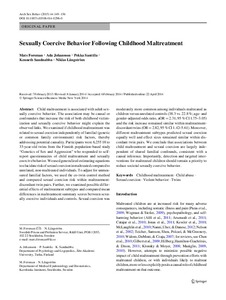Sexually coercive behavior following childhood maltreatment
Forsman M; Johansson A; Santtila P; Sandnabba K; Långström N
https://urn.fi/URN:NBN:fi-fe2021042715382
Tiivistelmä
Child maltreatment is associated with adult sexually coercive behavior. The association may be causal or confounders that increase the risk of both childhood victimization and sexually coercive behavior might explain the observed links. We examined if childhood maltreatment was related to sexual coercion independently of familial (genetic or common family environment) risk factors, thereby addressing potential causality. Participants were 6,255 18 to 33-year-old twins from the Finnish population-based study "Genetics of Sex and Aggression" who responded to self-report questionnaires of child maltreatment and sexually coercive behavior. We used generalized estimating equations to elucidate risk of sexual coercion in maltreated compared to unrelated, non-maltreated individuals. To adjust for unmeasured familial factors, we used the co-twin control method and compared sexual coercion risk within maltreatment-discordant twin pairs. Further, we examined possible differential effects of maltreatment subtypes and compared mean differences in maltreatment summary scores between sexually coercive individuals and controls. Sexual coercion was moderately more common among individuals maltreated as children versus unrelated controls (38.3 vs. 22.8 %; age- and gender-adjusted odds ratio, aOR = 2.31, 95 % CI 1.75-3.05) and the risk increase remained similar within maltreatment-discordant twins (OR = 2.82, 95 % CI 1.42-5.61). Moreover, different maltreatment subtypes predicted sexual coercion equally well and effect sizes remained similar within discordant twin pairs. We conclude that associations between child maltreatment and sexual coercion are largely independent of shared familial confounds, consistent with a causal inference. Importantly, detection and targeted interventions for maltreated children should remain a priority to reduce societal sexually coercive behavior.
Kokoelmat
- Rinnakkaistallenteet [27094]
